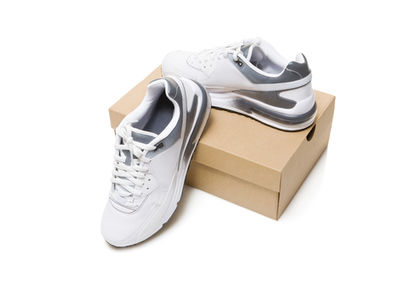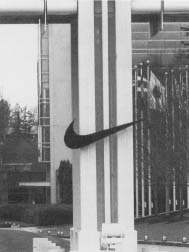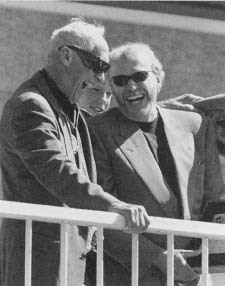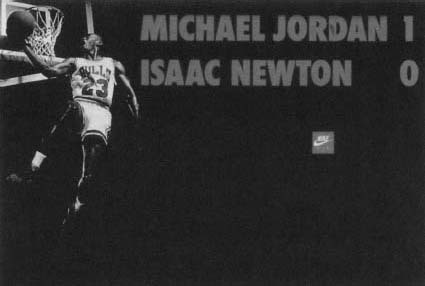Nike, Inc.

One Bowerman Drive Beaverton, OR 97005
(503) 671-6453
www.nike.com

A relatively young company, Nike, Inc. has existed for only thirty years yet has managed to become one of the world's top companies, selling not only athletic shoes, but athletic clothing and equipment in 140 countries around the world. Headquartered in Beaverton, Oregon, this athletic and apparel giant is named for the Greek goddess of victory, and is represented by a famous symbol, the "swoosh." The Nike swoosh is instantly recognizable, and has become an international symbol for athletes who strive for the very best.
Just Two Guys Who Like to Run
Nike was founded by two men who were rather obsessed with sports, Bill Bowerman (1911-1999) and Philip Knight (1938-). Bowerman was a World War II (1939-45) veteran who began coaching the track-and-field team at the University of Oregon in 1949. A hardcore athlete, he was a man thrilled with speed and running in all forms. He is frequently credited with bringing jogging as a form of exercise and sport into widespread popularity. Bowerman was such a skilled athlete and coach that the University of Oregon earned a reputation for excellence, and attracted athletes from around the world. One of these athletes was Philip Knight, who met Coach Bowerman in 1957.
While Knight competed on Bowerman's track team, the two became friends. They both enjoyed sports, especially running and jogging, and believed athletes could achieve greater balance and speed with better shoes. At the time, the athletic shoe market was ruled by German-made sneakers and tennis shoes manufactured by Adidas and Puma. None were really designed for running or jogging. Bowerman frequently experimented at home trying to create the perfect running shoe.
After Knight earned his business degree at the University of Oregon, he attended graduate school in California at Stanford University. In 1962, he received his master's degree in business administration (MBA). After graduation, Knight rewarded himself with a trip around the world. A very important stop was in Kobe, Japan, where he found, and fell in love with, Oniksuka Tiger shoes. Knight believed the shoes were far superior to the brands currently available in the United States. He bought a large shipment of the Tiger athletic shoes and made up a business on the spot. He called it Blue Ribbon Sports.
Nike at a Glance
- Employees: 22,000
- CEO: Phil Knight
- Subsidiaries: Bauer NIKE Hockey, Inc.; Cole Haan Holdings, Inc.; NIKE Golf; NIKE IHM, Inc.; NIKE Team Sports, Inc.
- Major Competitors: Reebok; Fila; Adidas-Saloman; Puma AG
- Notable Products: Nike Air; Nike Pegasus; Air Jordan basketball shoes; Typhoon ACG and Triax watches; Airelon sunglasses
Blue Ribbon Sports Is Born
After returning to the United States, Knight and Coach Bowerman decided to form a partnership. They used the name Knight had already created, Blue Ribbon Sports, and each contributed $500 toward their dream of selling better athletic shoes. Bowerman continued to coach at the University of Oregon while serving as the idea and design man of Blue Ribbon, tinkering and experimenting with various materials and types of shoe. Knight handled the business side of the company.
Timeline
- 1957:
- Bill Bowerman and Philip Knight meet at the University of Oregon.
- 1962:
- Knight travels to Japan and purchases Oniksuka Tiger shoes.
- 1964:
- Bowerman and Knight form a partnership; company makes $8,000 in first year.
- 1965:
- Blue Ribbon Sports hires its first employee.
- 1968:
- First Bowerman-designed shoe, the Cortez, takes the United States by storm.
- 1969:
- Knight quits his accounting job to focus on Blue Ribbon Sports; sales reach $800,000.
- 1971:
- Partners begin manufacturing their own shoes.
- 1972:
- Company is renamed Nike.
- 1979:
- Nike introduces its apparel line; company controls 50 percent of U.S. running shoe market.
- 1980:
- Nike becomes a public corporation with twenty-seven thousand employees.
- 1984:
- Sales hit just under $920 million.
- 1985:
- Company signs Michael Jordan to promote Nike shoes.
- 1988:
- Nike-Air shoes for men and women are introduced; "just Do It" ad campaign is launched.
- 1990:
- First NikeTown retail store opens in Portland, Oregon.
- 1995:
- Golfer Tiger Woods is signed as pitchman.
- 1999:
- Bill Bowerman dies at age eighty-eight.
- 2001:
- Sales reach over $9 billion; first NikeGoddess store for women opens.
The shipment of Tiger shoes took over a year to arrive in the United States. When they did, Knight stowed them in his parents' garage and began selling them from his car at sports events. The first year Blue Ribbon Sports was in business, the struggling firm made about $8,000. By 1965, the partners hired their first employee, Jeff Johnson, to help sell the Japanese shoes. Like Phil Knight, Johnson sold the shoes wherever and whenever he could, talking to athletes and demonstrating their high-quality craftsmanship.
In the meantime, Bowerman was busy making adjustments and improvements to the original shoe. A Bowerman-redesigned Tiger shoe, called the Cortez, became a best-seller with area sports enthusiasts and soon caught on across the United States. Cortez sales made the six-year-old company a success.
Based on Cortez sales, Bowerman and Knight decided they were ready to design and manufacture their own brand of shoes. They stopped importing shoes from Japan, and by the early 1970s were producing athletic shoes with a new type of rubber sole that had been crafted by Bowerman for speed and traction. The night before the company's first batch of custom shoe boxes was to be produced, Jeff Johnson suggested another improvement—a name change. His choice was a name taken from Greek mythology, Nike (pronounced NI-kee). Nike was the goddess of victory, an athletic beauty whose winged shoes and love of speed would be a perfect symbol for the young company. In 1972, Blue Ribbon Sports, Inc., officially changed its name to Nike.
Nike Takes the United States by Storm
In Nike's first year, Bowerman and Knight found an excellent way to introduce the fledgling firm to the world. Eugene, Oregon, happened to be hosting the Olympic trials and the partners gave some of the marathon runners Nike shoes to wear while competing. Two of the runners did very well, and the company had proof of the winning potential of its shoes. The company pulled in nearly $2 million in sales for the year; it also grew to forty-five employees. Knight devoted himself fulltime to the company, while Bowerman remained coach at the University of Oregon until 1972 when he retired to focus his energies on Nike and its growing athletic shoe line.
In 1971, Bill Bowerman made his first lightweight shoe sole by pouring rubber into his wife's waffle iron. According to Bowerman, every ounce he could remove from a shoe's sole would make a runner go even faster.
Nike continued to expand and gain attention, with sales topping $3 million for 1973. It also opened its first retail store in Santa Monica, California, which featured a variety of Nike-brand shoes. By 1979, Nike was the leading athletic shoe manufacturer in the United States, controlling half of this quickly expanding market. The company then introduced clothing to its product line, including a variety of shorts, running pants, and shirts.

By 1982, Nike spread its wings and started selling its famous brand internationally; this was also the year the company began a little advertising. Knight had never been a fan of advertising, but felt it was time to bring the Nike name to more Americans. He hired a small agency in Portland, called Weiden & Kennedy to craft a Nike image, although neither the agency nor Phil Knight had any idea their collaboration would eventually achieve worldwide attention. Over time, Nike ads would become almost more famous than the products the company produced.
Missed Trends and New Successes
While Nike had become a tremendous success, it was sometimes slow to respond to trends. For example, the company failed to recognize the potential of the aerobics craze of the 1980s. A new rival, Reebok International, did seize the opportunity and made millions. Nike bounced back in 1985 when it signed Michael Jordan (1963-) of the Chicago Bulls to promote its new Air Jordan basketball shoe. Early sales were good due largely to the "cool" television commercials that featured Jordan flying through the air.
In 1986, the company reached over $1 billion in sales, but Reebok still pushed Nike out of the top slot in the American athletic shoe market. The reason? Nike had continued to overlook a crucial part of the athletic market: women. Reebok had many styles and colors for women while Nike had traditionally looked to men and boys for its sales.
Missed trends caused Nike sales to drop to $850 million in 1987. That same year, however, a new line was released that would boost the company. The shoes featured a special cushioning system in the heel to reduce the stress of running on the foot and ankle. The new Air shoe line (not the same as the Air Jordan basketball shoes) had gas in the shoe's sole to create the cushion, which was like a shock absorber—absorbing the impact of the foot hitting the ground in the same way a shock absorber reduces bumps in the road for a car or truck.
Michael Jordan and Nike
In the early 1970s, Nike began sponsoring athletes as a way to gain attention for its shoes. Its first deal was with a runner named Steve Prefontaine (1951-1975), who was coached by Bill Bowerman at the University of Oregon. Prefontaine was an exceptional athlete with an attitude—he did things his own way, and didn't care what other people said or thought. Bowerman and Knight believed Prefontaine projected the perfect Nike image. They offered the runner money to wear Nike shoes when he competed and Prefontaine began wearing Nikes in 1973.
Sadly, Prefontaine's career was cut short when he died in a car crash in 1975. It would be another ten years before Nike again approached an athlete to wear its shoes. The young man Knight and Bowerman selected was Michael Jordan (1963-) who, in 1985, was just starting to make a name for himself in basketball as a player for the Chicago Bulls. Knight believed Jordan had loads of potential, just like young filmmaker Spike Lee (1957-), who was signed to produce several television ads featuring Jordan.
Lee created memorable commercials depicting how hard work and special Nike shoes made Jordan "fly." The ads were such a big success that everyone wanted to wear Air Jordan shoes. Jordan became known as "His Airness" and Nike quickly became an internationally known sports apparel company. Jordan and the Chicago Bulls went on to win six national titles, and the popularity of Air Jordan shoes continued to soar.
Jordan retired from basketball on two occasions, once to play baseball, then again to pursue other interests. In 2001, he returned to basketball to play with the Washington Wizards. Throughout his career changes, Jordan's popularity remained high and Nike continued to sell products. The Jordan line of shoes and clothing grew so much over the years, it was separated from other Nike products to form its own division. Michael Jordan even has his own office at Nike headquarters, and has played an active role in shaping what goes into the items bearing his name.

In 1988, the advertising campaign featuring the line "Just do it" was launched, and brought Nike instant acclaim as a company with hot products and a lot of attitude. The excitement generated by the ads made Nike the fashion sensation of the year and the company quickly regained the athletic shoe market from rival Reebok. Yet what enabled Nike to hold on to this market position in the coming years was finally taking notice of women buyers. Nike began sponsoring women athletes, initiated research on shoes specifically designed for female feet, and introduced footwear, apparel, and equipment.
Nike Captures the World
When Nike entered the 1990s, its sales had risen to $2 billion and it employed over five thousand people worldwide. For Knight and his top managers, however, this wasn't enough—they wanted to make Nike the world's leading athletic apparel and equipment company. A move in this direction was the purchase of the largest hockey and skating equipment producer, Canstar Sports, in 1995. By the mid-1990s, the Nike name had spread throughout the sports world: NFL football teams wore Nike-made jerseys and shoes; finalists in the U.S. Open tennis championships sported Nike gear; Nike sponsored New York City marathons; the company even outfitted major league soccer teams.
In 1995, sales were just under $5 billion, and Nike was indeed the top athletic shoe and apparel manufacturer in the marketplace. By the following year, sales leapt to over $6 billion, while Nike employees jumped to fifteen thousand throughout the world producing shoes, clothing, and equipment. Nike was on top not only in the shoe business; it had become one of the world's most successful companies.
The Nike Swoosh
The famous Nike "swoosh" was designed in 1971 by Carolyn Davidson, who was attending graduate school at Portland State University. She was paid $35 for this simple, yet rather interesting shape (it looks like a rounded checkmark), having no idea it would change the business world.
The trademark is so well known that the company often uses the symbol instead of its name in advertising on television and in magazines and newspapers. At company headquarters in Oregon, Nike has a giant red swoosh on the outside of its building instead of its name. In 1999, Marketing magazine declared the Nike swoosh to be Logo of the Century, beating out such famous symbols as McDonald's golden "M " arches. This made it the most recognizable logo in the world.
The Nike swoosh, however, is not only a marketing tool. It has become synonymous with hard work and success, and it appeals to a wide range of people—children, teens, and adults of all races and in dozens of countries around the world. Some people, like young athletes, have had the swoosh symbol shaved onto their heads or tattooed on their bodies. Nike cofounder Phil Knight even got a swoosh tattoo on his left ankle after several employees challenged him to do it.
The end of the 1990s brought a major change for Nike and Phil Knight when Bill Bowerman retired from the board of directors after thirty years. Just a few months later, Bowerman died on December 24, 1999, at his home in Fossil, Oregon. Knight, Nike employees, and hundreds of athletes past and present mourned the loss of Bowerman, a vital force in creating Nike and its one-of-a-kind products. While Bowerman could never be replaced, the company honored his memory with a new line of shoes carrying his name.
Into the Future
In the new century, Nike continues to grow. In 2000, the company had over twenty-two thousand employees in offices around the world, with five thousand of them working at the Beaverton, Oregon, "campus." Nike also continues its long tradition of research and development through their Nike Sports Research Lab, which opened in 1980.
In 2000, Tiger Woods (1975-), who like Michael Jordan had become another famous face for Nike, signed a new contract to pitch Nike golf products for another five years. That same year, Nike designed uniforms for over two thousand athletes at the Sydney, Australia, Olympic Games, and formed a women's division within the company, complete with its own vice president and advertising budget. Next came the opening of its first NikeGoddess store in Newport Beach, California, in 2001. There are plans for several more NikeGoddess stores to open in the United States over the next few years.
Whether for men or women, girls or boys, top athletes or beginners, Nike has shoes, apparel, and equipment for everyone. Over the years, it has become one of the world's top companies, recognized for quality athletic apparel, edgy advertising, and famous phrases. The ultimate goal, however, remains the same—a commitment to athletic fitness. According to the Nike Web site, "It's all about the athlete. Always has been, always will be."
Any information would be greatly appreciated.
Best Regards
Bob Brown